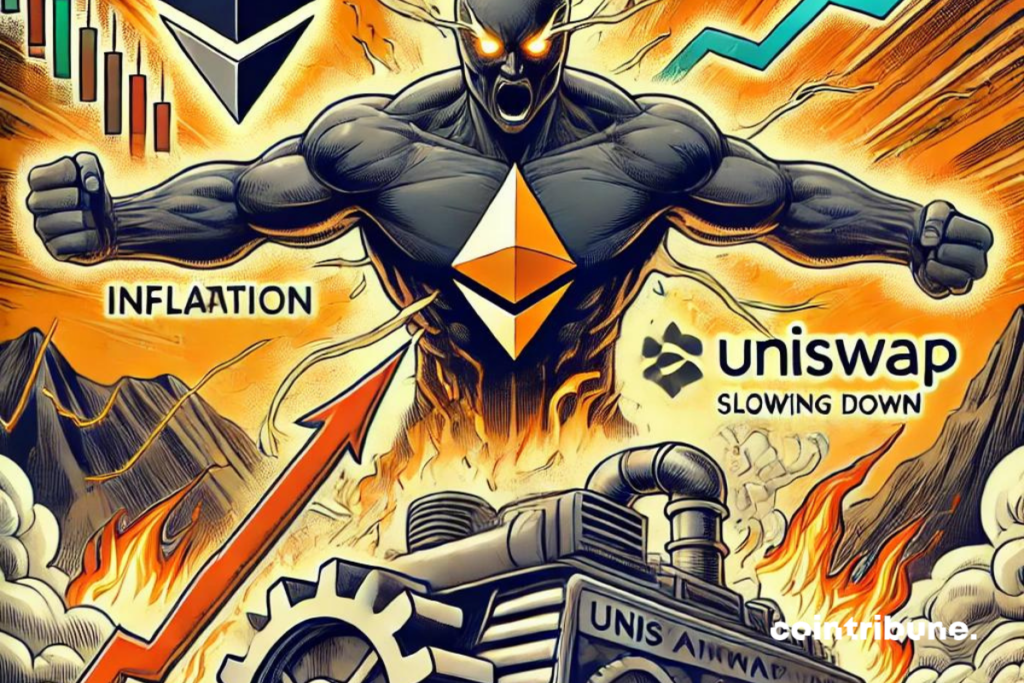Crypto: Ethereum Faces Unexpected Inflation
The world of crypto is in turmoil, and not just because of the usual price fluctuations. Ethereum, once praised for its deflationary mechanism, surprises by becoming inflationary for the first time in two years. Meanwhile, Uniswap, the giant of decentralized exchanges, is slowing its ETH burn rate, leaving observers puzzled. As these two crypto heavyweights navigate troubled waters, it’s time to dive into the details of this unexpected development.

Ethereum: From Deflation to Inflation
The year 2024 has marked a turning point for Ethereum crypto. After spending two years gradually reducing its supply through EIP-1559, Ethereum has taken an unexpected direction by becoming inflationary.
In the second quarter of this year, the network added a net total of 75,301 ETH to its supply, reversing the much-touted deflationary trend.
What happened? It all starts with decreased activity on the network. Indeed, the second quarter saw 228,543 ETH issued versus only 107,725 ETH burned.
This difference of 120,818 ETH added to the overall supply left experts perplexed. While it was thought that inflation was reserved for fiat currencies, Ethereum proves that even cryptos are not immune to surprises.
This sudden inflation reflects a decrease in activity on the network, raising questions about Ethereum’s future as a deflationary asset.
Although this situation is likely temporary, it highlights the challenges Ethereum must face, particularly regarding supply management during periods of low activity.
Uniswap: The Crypto Giant Slowing Down
Uniswap, one of the largest ETH burners, also experienced a notable slowdown in 2024. Although it burned 71,915 ETH this year, the burn rate significantly dropped in the second quarter.
Starting with an impressive 54,413 ETH burned in the first quarter, it plummeted to only 15,031 ETH in the second quarter, a decrease of 72.4%.
Why this sudden drop? The answer lies in decreased activity on decentralized exchanges, including Uniswap. Fewer transactions mean fewer gas fees, leading to a reduced ETH burn rate.
This slowdown could indicate a temporary change in investor appetite for decentralized exchanges, or perhaps a simple market readjustment after a period of euphoria.
Despite this decline, Uniswap remains a key player in the Ethereum ecosystem. However, its ability to influence the ETH supply heavily depends on user activity. If the crypto market doesn’t pick up quickly, we could see a prolonged period of reduced burning, with implications for ETH inflation.
Other Factors
Beyond Uniswap, other players in the Ethereum network also play a role in the supply dynamics. Trading bots like Banana Gun and Maestro, once significant ETH burners, saw their burn rates drop 74.3% and 74.6% respectively in the second quarter. This slowdown is explained by decreased trading on decentralized exchanges, which directly affects their ability to burn ETH.
Another noteworthy player is the Layer 2 blockchain Scroll, which is among the top ten ETH burners in 2024. This position can be attributed to users interacting with the network in hopes of receiving potential rewards, particularly a token airdrop, which might take place this year. The combination of these factors creates a complex landscape for Ethereum and its burn mechanism.
Maximize your Cointribune experience with our "Read to Earn" program! For every article you read, earn points and access exclusive rewards. Sign up now and start earning benefits.

Fascinated by Bitcoin since 2017, Evariste has continuously researched the subject. While his initial interest was in trading, he now actively seeks to understand all advances centered on cryptocurrencies. As an editor, he strives to consistently deliver high-quality work that reflects the state of the sector as a whole.
The views, thoughts, and opinions expressed in this article belong solely to the author, and should not be taken as investment advice. Do your own research before taking any investment decisions.